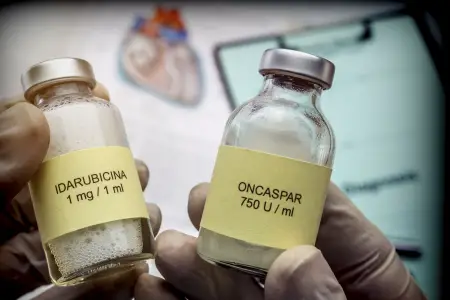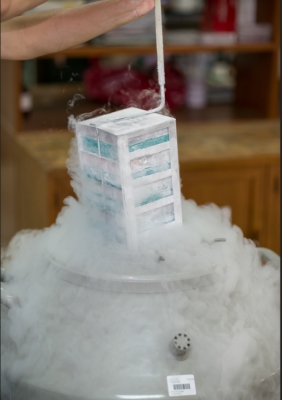Cord Blood Uses
Which Are Cord Blood Uses Today?
Baby stem cells are used for curing diseases and they are extracted from the umbilical cord blood. Cord blood uses today are in treating and curing a variety of different health problems, including anemia, osteoporosis, leukemia and lymphoma, to introduce some of them to this discussion.
In fact, cord blood can be used to treat and cure almost 80 diseases. Stem cells from cord blood are infused within the recipient’s bloodstream. Here, the stem cells get to work, repairing and healing damaged tissues and cells, a successful transplant creating a new, healthy immune system. Science has evidenced many cord blood uses, and established that cord blood stem cells are more efficacious than stem cells obtained from donors of bone marrow, leading to lesser incompatibilities with immune systems, incompatibilities like GVHD (graft-versus-host disease).
Cord blood uses appear in ‘hematopoietic stem cell transplantation’ procedures, what are procedures used to treat patients who suffer from disorders which affect their system of blood forming. Cord blood is comprised of blood-forming stem cells, capable of use on patients with blood cancers, and disorders of the immune system and blood, including WAS (Wiskott-Aldrich syndrome), SCD (sickle cell disease) and SCID (severe combined immunodeficiency).
The hematopoietic stem cells (HSCs) in cord blood are capable of forming into blood cells. Cord blood uses include transplants in those patients who needs these blood-forming cells regrown. This includes many cancer patients. Cord blood is also useful after treatments of chemotherapy. Chemotherapy indiscriminately kills cancerous as well as healthy cells. Transplanted HSCs from cord blood aid in the regrowth of healthy blood cells post chemotherapy.
Two types of transplants can be carried out as a result of cord blood banking. The first is what is referred to as an autologous transplant, where a stem cell transplant is conducted by use of the individual’s own cord blood stem cells. The second is what is referred to as an allogenic transplant, where cord blood stem cells donated by another person are transplanted within an individual. Both types of transplants increase the roster of cord blood uses. Where the donor is another family member, he is referred to as a related donor. On the other hand, should the donor not be from the family, he is referred to as an unrelated donor. In regenerative medicine, both types of transplants, autologous and allogenic, as used, depending upon the treatment.
Cord Blood Uses In Treatments: Anemia
CFord blood uses appear also in the treatment of anemia. Anemia refers to the development of a condition in which the blood lacks a sufficiency of hemoglobin or red blood cells that are healthy. Hemoglobin forms a core component of red blood cells, being used to bind oxygen. In case of a shortage or abnormality of red blood cells, your body doesn’t get sufficient oxygen, causing symptoms like fatigue, because the organs aren’t receiving what is needed for them to function correctly. Some forms of anemia are hereditary. Infants can be affected from the time they are born. Iron-deficiency anemia is a danger to those women who are in childbearing years, owing to the loss of blood through menstruation as well as an increase in the demands for blood supply while pregnant. A poor diet as well as suffering from other medical problems can increase the risk of the development of anemia. Anemia can afflict a person in a variety of different types. Some of these types pose health problems that can last throughout the individual’s life.
Cord Blood Uses In Treatments: Osteoporosis
Osteoporosis, meaning ‘porous bone,’ refers to a bone disease, triggered when the human body loses bone in quantities that are too great, or when the body stops making bone in sufficient quantities, or both. This results in a weakening of the bones, causing them to break from small accidents like a fall, or, if the case is really serious, from minor bumps or sneezing. When seen through a microscope, healthy bones resemble honeycomb. When the person suffers from osteoporosis, the spaces and holes within the ‘honeycomb’ become much larger in comparison with a healthy bone. Bones that are osteoporotic have suffered a loss of mass or density, containing abnormal structures of tissue. Losing density weakens bones, increasing the likelihood of their breaking. When people over the age of 50 break a bone, they ought to consult their doctor about carrying out a test for bone density.
Cord Blood Uses In Treatments: Leukemia
Leukemia refers to a malignant cancer of the blood cells. It causes the production of abnormal blood cells in the bone marrow. Usually, the abnormal blood cells are white blood cells, the cells that are responsible for combating infection. White blood cells in patients with leukemia do not function as they should. The abnormal cells proliferate, eventually outnumbering the normal blood cells, resulting in making it difficult for the human body to fight off infections, transport oxygen and control bleeding. Cord blood uses also appear in the treatment of leukemia.
Different types of leukemia exist, depending upon the types of abnormal blood that are produced, and the rate at which the development of the disease takes place. If the disease develops rapidly, it is referred to as an acute leukemia. Significant amounts of leukemia cells collect extremely rapidly within the blood, causing symptoms like easy bruising, tiredness and increased vulnerability to infections. An acute leukemia needs aggressive and fast treatment.
A second kind of leukemia is referred to as chronic leukemia, leukemia that develops over time, slowly. These leukemias can be asymptomatic in the beginning. But, unless they are treated, the abnormal cells can reach large numbers, the same as in acute leukemia, resulting in symptoms that are similar.
Leukemias can be broken down into further classifications, lymphoid and myeloid, dependent upon what type of white blood cells comprise the leukemia cells.
The exact causes of leukemia remain unknown. But the causes are believed to include a combination of environmental and genetic factors. These leukemia cells acquire mutations within their DNA, mutations that result in their abnormal growth, depriving them of the capabilities of normal white blood cells. But it is not apparent why the mutations occur.
Cord Blood Uses In Treatments: Lymphoma
Lymphoma refers to a cancer, a cancer that starts within the immune system’s infection-fighting cells, cells called lymphocytes. These cells are present with the bone marrow, thymus, spleen, lymph nodes as well as other body parts. For patients who have lymphoma, their lymphocytes alter, growing out of control. The two main types of lymphoma are non-Hodgkin and Hodgkin.
These two different types of lymphoma are concerned with different kinds of lymphocyte cells. Each type grows at different rates, responding to treatment differently. Lymphoma is now treatable, depending on its type and stage.
Cord Blood Uses In Treatments: WAS (Wiskott-Aldrich syndrome)
WAS usually occurs in males, owing to the fact that it is caused by a pattern of inheritance that is recessive and X-linked. It is a rare disease, affecting between 1 and 10 males in every million, however recent cord blood uses include the treatment for this condition. The first symptoms are normally bruising and petechiae, a consequence of thrombocytopenia, low blood platelet count. Other symptoms include bloody diarrhea, spontaneous nose bleeding and eczema, usually developing within the first month of living. By the first three months, bacterial infections develop recurrently. Also common is the enlargement of the spleen. Most children with WAS also acquire at least a single autoimmune disorder as well as cancers like leukemia and lymphoma.
Cord Blood Uses In Treatments: SCD (Sickle cell disease)
SCD refers to a group of blood disorders usually inherited from the patient’s parents. Cord blood uses are identified in the treatment of this condition too. The most common of these is SCA (sickle cell anemia). SCD occurs because a person has inherited two abnormal versions of the hemoglobin gene, one each from both parents. It is characterized by an abnormality in hemoglobin, the protein in blood that carries oxygen. SCD symptoms usually manifest at the age of about 5 or 6 months old. It can cause a wide variety of health issues, for example, attacks of pain, swelling of the feet and hands, anemia, stroke and bacterial infections. As patients grow older, they may also develop long-term pain. People suffering from SCD in the developed world have a life expectancy of 40 to 60 years.
Cord Blood Uses In Treatments: SCID (severe combined immunodeficiency)
SCID is potentially fatal, a primary immunodeficiency where there is the combined absence of B-lymphocyte and T lymphocyte functions. 13 different genetic defects can be the cause behind SCID. These defects leave the patient vulnerable to several serious infections. The condition is regarded as the most serious of all primary immunodeficiencies. Many states in the United States have incorporated SCID to their newborn screening panel.
Cord Blood Uses Require Matching Cells
It is crucially important to make sure that the cells of the donor are a match with the cells of the recipient. Where there is no suitable match, and the transplant is carried out anyway, the consequences will be dire and there will be no cord blood uses at all. The transplanted stem cells will end up attacking the patient’s own body post-transplant. This is referred to as GVHD (graft versus host disease). It is a serious, potentially fatal complication in transplant medicine, causing harm to the skin, respiratory system, digestive tract, the gut as well as a host of other organs. There is less chance of graft versus host disease (GVHD) when the donor of cord blood stem cells is a related donor as opposed to an unrelated donor.
While peripheral blood and bone marrow steam cell transplants from unrelated donors require an exact match between donor and recipient, cord blood stem cells do not, being more adaptable and primitive. Suitable cord blood donors are, therefore, faster and easier to find, with reduced chances of graft versus host disease, improving chances of having more cord blood uses. Even if graft versus host disease is present in cord blood stem cells, it is normally less severe.
HLA (human leukocyte antigens) are markers or proteins located on most cell and tissue surfaces in the human body. Every individual possesses particular HLA markers, recognizing what cells belong in that particular body. When two people share predominantly the same HLA, they are considered a “match.” Immunologically, their tissues are compatible with one another. A child is always 100% compatible with his own cord blood stem cells.
Misunderstandings About Cord Blood Uses Abound
Insufficient knowledge pertaining to how cord blood is collected, processed and stored discourages a host of new parents from storing the cord blood cells. The parents need to be educated, provided with comprehensive information regarding the steps taken for collecting, processing and storing cord blood, and learn about the cord blood uses.
Their fears need to be addressed and quelled, and the advantages f cord blood uses explained throughly, assuring them that the methods employed entail neither risks nor pain to mother and child. Cord blood needs to be collected and stored, possessing, as it does, therapeutic benefits that are nearly miraculous, capable of saving lives in a multitude of different ways.
Public and Private Cord Blood Banks: Different Banks, Different Cord Blood Uses
Cord blood stem cells, once collected, can be couriered to places for either private use, or for use by the general public. Private cord blood banks store cord blood stem cells for private use in transplantation. They cater to the use of the families doing the storing only. The donor reserves the right to be the recipient of the deposited blood for his personal transplants needs, or for the needs of his family members. On the other hand, public banks offer the donated cord blood to the general public, reducing the donor’s chances of being the recipient of it, opening the donated blood to use by someone who needs it.
The majority of both public and private banks were founded in the 1990s. Public banks impose strict rules for the donors utilizing their storage facilities. The donors and their blood samples are screened to gauge their eligibility for cord blood banking so the future recipient can enjoy all the cord blood uses. Expecting parents are expected to contact public banks 34 weeks prior to their baby’s delivery.
Those interested in donating their samples are recommended to search for the location of either a public or private blood bank nearest to them. Donors are also advised that, should they choose a public bank, once they have been screened and their samples collected, the samples will be stripped of all information identifying the donor. These samples, once donated, cannot be retrieved for use in their own needs for transplant.
Private cord blood banks, on the other hand, are geared to cater solely and wholly to the needs of the customers, therefore, all the cord blood uses will be for the customer. They charge sizeable fees, between $1,500 and $2,000 in order to preserve their sole rights to all the cord blood uses. These fees can be further added to by maintenance fees of around $100. Some banks also offer savings of about $500 if an upfront fee is paid during the banking process. The high fees can deter some parents. If, however, the family is certain that their children and their siblings are healthy, they can make the choice to later sell or donate their stored blood to those in need of it.
Non-profit private cord blood banks offer to store the cord blood stem cells for free. However, you are advised to take note of their efficiency in processing the cells, and how frequently they use the blood in transplants, before you trust them with your blood samples.
Private cord blood banks store cord blood for you. They give you complete control over when it is accessed and how the blood is used. Public banks, on the other hand, may send the blood off for further scientific research. Cord blood uses are different according to the type of cord blood banking.
As a conclusion of this point, cord blood banks are not all the same. They can, as has been stated, offer different services depending on whether they are public or private, for-profit or non-profit. Private banks are more expensive and store the blood for longer but offer all the possible catalog of cord blood uses.
If your family has a history of illnesses that may require transplant, it is better to store cord blood in a private bank so the cord blood uses will be for the owner. If there is no such history, it is equally beneficial for you to choose a private banking facility.
Cord Blood, Stem Cells And The Cord Blood Uses
Cord blood refers, as we know already, to blood that stays in the umbilical cord, attached to the placenta, after childbirth. Blood from the umbilical cord, once considered waste material, used to be discarded. But now it is used to harvest stem cells. Cord blood is, therefore, collected for the stem cells that it contains, which can be used to serve a wide variety of cord blood uses with manifold medical purposes. 80ml-120ml of blood can be collected from the cord and placenta, amounting to one-third to a half a cup. Cord blood is made up of all elements that are present in whole blood, including platelets, plasma, white blood cells, red blood cells, and is particularly rich in HSCs (hematopoietic stem cells).
Stem cells possess uniqueness, capable of becoming a variety of different kinds of cells, replicating rapidly. They are widely instrumental in healing the body. Stem cells can be used to treat many different conditions through diverse cord blood uses. Ever since we discovered how and where these cells could be isolated, we have been using them to carry out transplants. Stem cells belonging to the same individual are compatible 100% of the time. But it is risky to use stem cells belonging to someone else, particularly is the recipient and donor aren’t immediately related. We have methods to ascertain whether a donor’s will be compatible with the recipient’s. Stem cells found in cord blood possess advantages over stem cells acquired in other ways. Researchers are discovering more cord blood uses and more diseases that stem cells can be used to treat.
Cord blood uses increment thanks to the stem cells, that possess two unique properties. Firstly, they are capable of multiplying to produce more stem cells, meaning that a small number of stem cells can be fostered to produce many more. Secondly, they can transform, as mature stem cells, into any kind, making them useful for any diseased organ that their recipients might suffer from. This is why they are considered so priceless, generating a multitude of stem cells from a small starting number, offering a diverse range of advantages for many medical conditions.
The future of cord blood uses
Nearly 40 years have passed since the first proposal of the usefulness of cord blood. The industry of cord blood banking is consolidating and maturing today. Disovery of new cord blood uses carry new opportunities.
A prominent trend in the industry of cord blood banking worldwide is the pairing of tissue storage with cord blood, offering more genetic services, and more cord blood uses, including post and pre-natal genetic testing, metabolic screening and genome sequencing. This trend is growing, owing to the providers’ ability to offer existing clients complimentary services, diversifying and expanding the product portfolios of cord blood banking providers. They are enhancing their relationships with the mothers.
Cord blood banks are as we said, additionally expanding their services, offering storage for many kinds of perinatal tissues, including amnion, placental, cord tissue and cord blood and each time more cord blood uses. They are also targeting the storage of stem cells at different points in their lifecycles, including adipose-derived stem cells, dental plum stem cells and more.
There have also been many clinical trials using technologies for cord blood expansion ex vivo, trials which have been promising, with many experimenters having developed products in phase 2 of their clinical trials. For the first time in human history, data concerning human efficacy is in the process of being collected for a variety of different kinds of cord blood expansion technologies at the same time.
As a conclusion, there are many cord blood uses that justify to pay the cost of private cord blood banking. If you need help to select a bank, see this article that are our updated cord blood banking reviews.







Thanks for your exciting article. Other thing is that mesothelioma cancer is generally the result of the inhalation of dust from asbestos, which is a dangerous material. It really is commonly witnessed among staff in the engineering industry who definitely have long contact with asbestos. It is also caused by residing in asbestos insulated buildings for a long period of time, Genetic makeup plays a huge role, and some folks are more vulnerable to the risk compared to others.